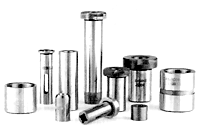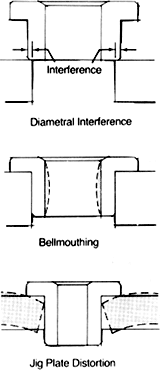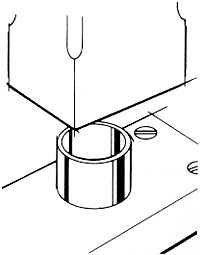When you think about raising machine uptime, improving hole quality, and lowering tooling costs, you might not give much thought to the bushings you’re using. But perhaps you should.
Holemaking and hole-finishing operations such as gundrilling, reaming, tapping, multispindle drilling, and drilling to depths greater than 2 diameters require the use of guide bushings. Bushings come in a wide range of lengths, IDs, ODs, designs, and materials. Selecting the proper bushing style for a given application can ensure the production of round, straight holes, no matter how challenging the application may be.
 Figure 1: Standard bushings may be headed or headless and may include oil grooves (at right). |
|
Bushing designs include headless or headed press fit (Figure 1), fixed renewable, and slip fixed renewable.
Headless press fit. This low-cost bushing, designed for single-stage drilling, is pressed into the jig plate until flush with its surface. Because it is headless, the bushing is ideal for use in limited space and close hole arrangements. When worn, the bushing must be drilled out.
Headed press fit. This inexpensive bushing is used when high pressure, caused by high removal rates that produce chip buildup between the spindle and the bushing, could force a headless bushing through the jig plate.
Fixed renewable. This type is used with bushing liners and is held in place with a lock screw. It is designed for use on part runs longer than the life of a typical bushing, because it is easy to replace when worn without removing the jig from production. Bushing wear can be caused by tool impact, a particularly hard workpiece material (because chips of the material contact the bushing wall as they exit the drill flutes), a nonperpendicular angle of entry, or poor alignment.
 Figure 2: Bushing liners help ensure a precise location point for the replacement of slip or fixed renewable bushings and protect the jig plate from wear caused by bushing replacement. A headless liner is depicted here. |
|
Bushing liners facilitate bushing replacement. The liners, available in headed or headless styles, are pressed permanently into the jig (Figure 2). They maintain a precise locating point for bushing insertion and protect the jig plate from wear caused by frequent bushing replacement. Headed liners are recommended for applications in which high pressure or pounding could push liners through the jig plate.
Slip fixed renewable. Used with a headed or headless bushing liner permanently pressed into the jig, a slip fixed renewable bushing is locked in place with a lock screw or a slip lock. This permits more than one operation to be performed on the same hole, such as drilling and reaming, without disturbing the workpiece. Drill and reamer bushings can be interchanged in the same liner without affecting centering accuracy. Slip bushings feature a knurled head to aid removal.
The various bushing designs are identified by a combination of letters and symbols in accordance with American National Standards Institute (ANSI) designations. The ANSI identification system is illustrated in Figure 3.
 Figure 3: The ANSI identification system for bushings. |
 Figure 4: Bushings may include coolant bores or slots to provide chip-flushing capability. |
|
Some applications require special bushing designs, such as bushings with longer lengths, which can butt up to the workpiece and afford greater accuracy; bushings with thin walls for use in high-precision close hole patterns; and directed-coolant bushings for drilling hardened steels that require cooler-running drills. Bushings also may come with coolant holes through the bushing wall to permit effective chip flushing during cutting (Figure 4). This feature is especially useful in high-production applications involving high feed rates or when the bushing is in direct contact with the workpiece.
No matter what style of bushing is chosen, it should have the following characteristics: a superfinish to minimize wear, a blended radius at the top of the bushing to minimize tool damage resulting from misalignment, a high Rockwell hardness to maximize bushing life, concentricity and roundness to maintain positioning accuracy, an OD chamfer at the bushing bottom to prevent peening over (mushrooming ends caused by chip accumulation), and an ID break or chamfer to facilitate chip clearance and reduce tool wear.
Fit and Installation
 Figure 5: Improper fits between the bushing and the jig plate can cause bellmouthing or jig-plate distortion. Interference fits are recommended. |
|
Accuracy in production operations depends on proper mounting-hole preparation and bushing and liner installation. Diametral interference fits and the distance between the bottom of the bushing and the workpiece are important factors to consider.
Diametral interference fits of 0.0005" to 0.0008" for headless press fit bushings and 0.0003" to 0.0005" for headed press fit bushings are recommended between the bushing OD and the mounting hole ID to provide adequate gripping force. This fit typically will hold the bushing in the jig without distorting the jig plate or the bushing bore. As Figure 5 illustrates, improper fits can cause bellmouthing or jig-plate distortion. Fixed renewable bushings require a diametral clearance of 0.0001" to 0.0006" to ensure accuracy and ease of replacement.
In terms of OD, bushings should be twice the diameter of a typical twist drill. A bushing should be long enough to hold the drill’s entire shank steady. If the bushing is too short, the tool will be allowed to bend. However, if the bushing is too long, the drill will have to be longer than necessary to produce the desired hole. The results of this latter scenario may include accelerated drill wear, chip interference, drill breakage, and poor hole roundness and straightness.
Clearance between the bottom of the bushing and the top of the workpiece should be 1 to 1.55 the drill diameter to allow room for chip removal and thus minimize chip abrasion of the bushing (Figure 6). Bushings can be provided with chipbreaker ends to facilitate chip removal (Figure 7).
 Figure 6: Locate the bushing a sufficient distance from the jig plate to permit chip clearance. |
|
 Figure 7: Bushings may incorporate chipbreaker bottom edges. |
|
 Figure 8: Maintain centerline perpendicularity when pressing bushings into the jig plate. |
|
In some cases, it’s best to leave a distance equal to half the bushing ID between the bushing and the workpiece to permit chip clearance. The distance should be greater for materials such as soft steels that produce long stringy chips.
If the tool must approach the workpiece at a nonperpendicular angle, the bottom of the bushing should be parallel to the workpiece surface after being cut or ground to the angle necessary to match the workpiece contour and should be located very close to the workpiece surface.
The bushing bore should allow 0.0001" to 0.0007" of clearance for the cutting tool, depending on the tool’s diameter. This allows the tool to approach the workpiece without interference while providing enough support to help the tool produce round, straight holes. Drill bushings and reamer bushings each have specific hole tolerances related to bushing ID and OD. Bushing-bore concentricity should range from 0.0000" to 0.0003" TIR on finish-ground parts up to 0.5000" in diameter; for parts larger than that, concentricity should range between 0.0000" and 0.0005" TIR.
Jig plates, or multiple bushing-bore fixtures in the case of high-production operations, are usually made of cast iron or unhardened steel. They should be thick enough to hold and support the bushings. When using a thick bushing plate to support a long drill, go with an extended-length bushing that’s relieved to maintain proper contact length through the plate. Bushing mounting holes should be jig-bored or sized with a reamer to ensure roundness.
Use a hand arbor to install press-fit bushings in jig plates to ensure centerline perpendicularity to the plate (Figure 8).
Bushing Wear
After guiding cutting edges for many cycles, bushings begin to wear. Along with proper installation, selecting the optimum bushing material for a given application can delay this wear considerably.
Drill bushings are made from either high-carbon chromium steel (with a bore hardness of Rc 58) for low-production applications in which low price supersedes wear resistance, nitrided alloy steel for applications involving deep holes or abrasive work materials, or carbide for maximum wear resistance. Nitrided steel bushings generally provide up to 2.55 the wear resistance of standard steel, while carbide bushings provide up to 2505 the wear resistance of steel, depending upon the application. Carbide bushings are becoming increasingly popular among shops engaged in high-production operations. Though more expensive initially, carbide is less vulnerable to chip abrasion than other materials and reduces the number of bushing replacements needed, saving both replacement time and the cost of replacement bushings. For smaller part runs, justifying the cost of carbide bushings may be impossible. In these cases, nitrided alloy-steel bushings are more economical and still provide significant wear resistance.
Most importantly, nitrided-steel and carbide bushings maintain their integrity longer, producing higher quality holes. Machinists often overlook the key role bushings play in the production of round, straight holes. If you select and properly apply the appropriate bushing style, specifications, and material, drill bushings can help improve metalcutting accuracy and repeatability while reducing tool change downtime.
About the Author
George Taylor is director of application engineering with Briney Tooling Systems, Bad Axe, MI.
Related Glossary Terms
- abrasive
abrasive
Substance used for grinding, honing, lapping, superfinishing and polishing. Examples include garnet, emery, corundum, silicon carbide, cubic boron nitride and diamond in various grit sizes.
- angle of entry
angle of entry
Determined by the position of the milling cutter’s centerline relative to the edge of the workpiece. Depending on the cutter diameter and the radial width of cut, the angle of entry can be negative or positive. A negative angle of entry occurs when the cutter’s centerline is located on the workpiece. Such an angle is recommended because the insert contacts the workpiece by its strong front rake, not by its weak cutting edge. To produce a negative angle of entry, the radial width of cut should exceed the cutter radius. A positive angle of entry occurs when the cutter’s centerline is not located on the workpiece. It happens when the radial width of cut is less than the cutter radius. A positive angle of entry should be avoided because the insert contacts the workpiece by its weakest part—the cutting edge.
- arbor
arbor
Shaft used for rotary support in machining applications. In grinding, the spindle for mounting the wheel; in milling and other cutting operations, the shaft for mounting the cutter.
- bushing
bushing
Cylindrical sleeve, typically made from high-grade tool steel, inserted into a jig fixture to guide cutting tools. There are three main types: renewable, used in liners that in turn are installed in the jig; press-fit, installed directly in the jig for short production runs; and liner (or master), installed permanently in a jig to receive renewable bushing.
- centering
centering
1. Process of locating the center of a workpiece to be mounted on centers. 2. Process of mounting the workpiece concentric to the machine spindle. See centers.
- chip clearance
chip clearance
In milling, the groove or space provided in the cutter body that allows chips to be formed by the inserts.
- chipbreaker
chipbreaker
Groove or other tool geometry that breaks chips into small fragments as they come off the workpiece. Designed to prevent chips from becoming so long that they are difficult to control, catch in turning parts and cause safety problems.
- clearance
clearance
Space provided behind a tool’s land or relief to prevent rubbing and subsequent premature deterioration of the tool. See land; relief.
- coolant
coolant
Fluid that reduces temperature buildup at the tool/workpiece interface during machining. Normally takes the form of a liquid such as soluble or chemical mixtures (semisynthetic, synthetic) but can be pressurized air or other gas. Because of water’s ability to absorb great quantities of heat, it is widely used as a coolant and vehicle for various cutting compounds, with the water-to-compound ratio varying with the machining task. See cutting fluid; semisynthetic cutting fluid; soluble-oil cutting fluid; synthetic cutting fluid.
- feed
feed
Rate of change of position of the tool as a whole, relative to the workpiece while cutting.
- gundrilling
gundrilling
Drilling process using a self-guiding tool to produce deep, precise holes. High-pressure coolant is fed to the cutting area, usually through the gundrill’s shank.
- hardness
hardness
Hardness is a measure of the resistance of a material to surface indentation or abrasion. There is no absolute scale for hardness. In order to express hardness quantitatively, each type of test has its own scale, which defines hardness. Indentation hardness obtained through static methods is measured by Brinell, Rockwell, Vickers and Knoop tests. Hardness without indentation is measured by a dynamic method, known as the Scleroscope test.
- inner diameter ( ID)
inner diameter ( ID)
Dimension that defines the inside diameter of a cavity or hole. See OD, outer diameter.
- jig
jig
Tooling usually considered to be a stationary apparatus. A jig assists in the assembly or manufacture of a part or device. It holds the workpiece while guiding the cutting tool with a bushing. A jig used in subassembly or final assembly might provide assembly aids such as alignments and adjustments. See fixture.
- metalcutting ( material cutting)
metalcutting ( material cutting)
Any machining process used to part metal or other material or give a workpiece a new configuration. Conventionally applies to machining operations in which a cutting tool mechanically removes material in the form of chips; applies to any process in which metal or material is removed to create new shapes. See metalforming.
- outer diameter ( OD)
outer diameter ( OD)
Dimension that defines the exterior diameter of a cylindrical or round part. See ID, inner diameter.
- parallel
parallel
Strip or block of precision-ground stock used to elevate a workpiece, while keeping it parallel to the worktable, to prevent cutter/table contact.
- peening
peening
Mechanical working of a metal by hammer blows or shot impingement.
- reamer
reamer
Rotating cutting tool used to enlarge a drilled hole to size. Normally removes only a small amount of stock. The workpiece supports the multiple-edge cutting tool. Also for contouring an existing hole.
- shank
shank
Main body of a tool; the portion of a drill or similar end-held tool that fits into a collet, chuck or similar mounting device.
- tapping
tapping
Machining operation in which a tap, with teeth on its periphery, cuts internal threads in a predrilled hole having a smaller diameter than the tap diameter. Threads are formed by a combined rotary and axial-relative motion between tap and workpiece. See tap.
- total indicator runout ( TIR)
total indicator runout ( TIR)
Combined variations of all dimensions of a workpiece, measured with an indicator, determined by rotating the part 360°.
- twist drill
twist drill
Most common type of drill, having two or more cutting edges, and having helical grooves adjacent thereto for the passage of chips and for admitting coolant to the cutting edges. Twist drills are used either for originating holes or for enlarging existing holes. Standard twist drills come in fractional sizes from 1¼16" to 11¼2", wire-gage sizes from 1 to 80, letter sizes A to Z and metric sizes.
- wear resistance
wear resistance
Ability of the tool to withstand stresses that cause it to wear during cutting; an attribute linked to alloy composition, base material, thermal conditions, type of tooling and operation and other variables.






